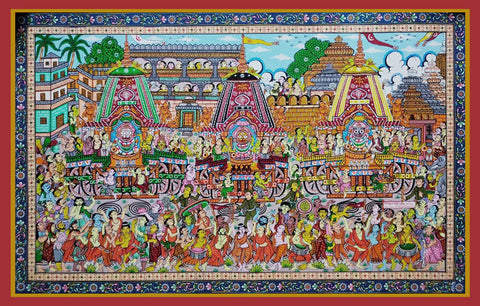This is an example of Orissa's typical Pattachitra painting. To create a traditional Pattachitra painting, the skilled chitrakar or the illustrators adhere to a time-honored process involving the creation of a special cloth canvas called Patta, upon which the Chitra or the painting is deftly crafted. Regarded as one of the most ancient and renowned art forms, the roots of the Pattachitra can be traced back to the 12th century originating in the villages of Odisha.

In this masterfully crafted scroll art, the much-anticipated spectacle of Jagannath Yatra has been brought to light. Jagannath or the ‘lord of the universe’ is a highly revered form of Vishnu and also a prominent motif of Pattachitra art. In one of the legends surrounding the creation of the idols, Lord Vishwakarma spent months meticulously creating the idols of the three divine siblings at what is now known as Gundicha temple. One day, Queen Gundicha, in her impatience, pushed open the temple door. This sudden intrusion caused Lord Vishwakarma to disappear, leaving the statues unfinished.
This event led to an yearly tradition where Jagannath along with his siblings, Balbhadra, and Subhadra- emerge from the sacred garbhagriha, the sanctum sanctorum- to return to their birthplace.
The Jagannath Rath Yatra transcends the notion of any ordinary procession. The word Yatra in this context carries a profound significance, symbolizing a sacred odyssey to one's roots. It exemplifies the celebration of the journey itself. This Pattachitra painting captures the initial stages of the yatra, depicting the rising fervor as the devotees accompany the Gods to the Gundicha temple.
At the heart of the painting, the trio commands the utmost attention. Adorned in colorful garlands and vibrant attire, they radiate their divine presence. Devi Subhadra’s saffron or yellow complexion stands for her sacred and auspicious presence. Jagannath’s black complexion is analogous to Lord Krishna’s color, the word Krishna itself means “all-attractive” or “dark-colored”. Black is unfathomable, Jagannath is beyond our understanding, beyond all the measures. Furthermore his black color is also linked to the symbolism of farmers who get tanned after their long exposure to the sun while toiling in their fields. Lord Balbhadra or Balarama, on the other hand is a non-mysterious manifestation of Vishnu, he is strong but gentle and so he is bright and white.Their gaze seems to be tenderly fixed upon their beloved children, while their children sway in their devotion. Equally captivating are their colossal, multicolored chariots on which they are majestically seated. The large painted wheels of the chariot add to the grandeur and symbolism. Subhadra’s chariot, known as Dwarpadalana is draped in a covering of red and black cloth, the latter being associated with Shakti or Maa Durga. Since Balram is associated with agricultural and pastoral activity, the green color of his chariot, Taladhwaja,signifies his connection to the earth. Nandighosh, the chariot of lord Jagannath, reflects his affinity for pitambar( yellow silk) cloth. Another notable aspect is the presence of the shikaras or the rising towers of the temple which form an exquisite backdrop in this case. The chitrakar has taken great care to showcase the rich architectural heritage and craftsmanship of the temple by highlighting the detailed carvings of the tower.
However, the painting’s true brilliance lies in the illustration of the panoramic procession. The chariots accompanied by joyous devotees and celebrators, create a spirited atmosphere. The entourage includes saints and soulful Kirtan singers donning saffron attire with their cherished mrdangas (two-sided drums) suspended from their necks, and their voices resonating with devotional prayers fill the air. Graceful Odissi dancers, bedecked in traditional attire, enhance the spectacle with their elegant movements. Ardent devotees and common folk alike can be seen immersed in the festivity, expressing their heartfelt devotion.
The representation of the temple priests and the chariot pullers cannot be ignored. The temple priests offering their service to the deities showcase their age-old knowledge and reverence for the customs. Meanwhile, the enthusiastic chariot pullers can be seen exerting their strength, propelling the grand chariots with utmost zeal. Amidst the vibrant assembly, stoic guards holding their laathis, stand watch, ensuring order and a smooth progression of events. Some devotees can be seen singing, while others dancing, and yet others can be seen fully immersed in the ocean of celebration. Finally, Pattachitra paintings feature an essential floral border, as exemplified in this artwork, that is adding to the traditional touch to its overall sublimity.
Every inch of the painting is filled with activity and presence. Despite the abundance of visual elements, the meaning conveyed can be deciphered with relative ease. The beauty lies in how this colorful Pattachitra art has subtly encapsulated the essence of inclusion and the connection between Atma and Paramatma through a visually appealing composition. Enabling even the common viewers to understand and appreciate the spectacle of Rath Yatra.























